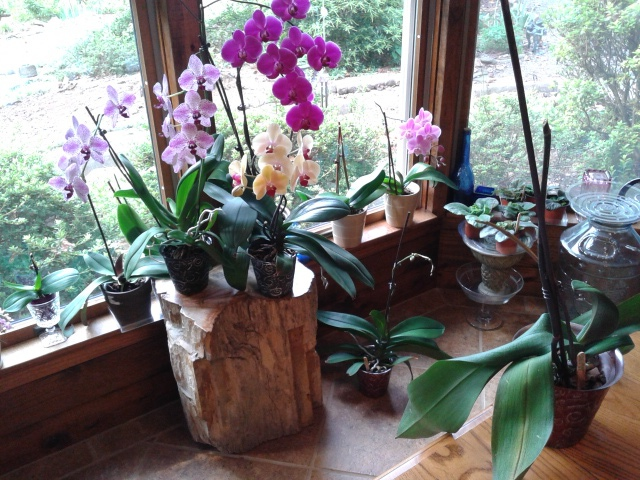Question Aug 14, 2014
Aug 14, 2014
QUESTION: Hello! I'm new to orchids, but having great success it appears. All 3 I purchased last Christmas are blooming again! Then I purchased 4 rescues from Lowe's & am seeing new roots, leaves & some flower spikes & now one is blooming!So they seem to like what I'm doing--so I will keep that up. My questions are general info about these (all) Phalaenopsis orchids:
1. What to do about leaves that remain limp, shriveled or twisted (see foreground plant). I have cut off leaves that turn yellow.
2. Seeing some tiny gnats(?) coming out of bark media when watering--both w/gnats came from overwatering near-deaths.
3. Also some leaves are splitting down center: what to do about that?
4. The sun is moving into the house as season changes. Would these be able to take all day sun, or need to move them to less bright area? (passive solar home)
5. What to do with dust on leaves.
6. What would cause round brown spots on leaves or at tips?
7. When to know it's time to repot, the plant and I have one keiki
Attached is a pic taken this morning. Thanks for helping! I'm lovin' these orchids
ANSWER: Thanks for the picture and questions. Congratulations on your growing and flowering success. Since you are currently doing so well, my advice will apply to future growing. Problems with phalaenopsis are of two general types: pests and rotting potting mix. It is generally recommended that phalaenopsis be repotted in fresh orchid bark mix every one to two years. This is because in that period of time the existing potting mix degrades. As a result, the potting mix breaks down to finer, more moisture retentive particles-- particles that also restrict tha flow of air to the roots. Unlike many house plants, orchid roots require a more open potting mix. Indicators of potting mix degradation are 1) the presence of small gnats which thrive in moist, soil-like conditions, and 2) root rot. In the latter, the outer sheath of root collapses. With root loss, one or more leaves become nutrient and/or water`deficient. The leaf may then wither and/or fall from the plant.
Repotting should best occur when a plant goes out of flower and prepares for new root growth. I see no signs of leaf burning due to too much sun exposure. If, and when, that occurs, you will need to move the affected plant to a shadier location. Best temps for phalaenopsis are 75-85 Degrees.
---------- FOLLOW-UP ----------
QUESTION: thanks for your answer! It all makes great sense & I understand. Have had some roots rotting like you said, but plenty of new bright ones, too.
Would the "other than perfect-looking" leaves need to stay on the plant? I'd like to get rid of a couple, but if they are beneficial, not just hogging up strength, then I will leave them until they dry up.
Thanks again, I appreciate your info & will share with some new orchid-er friends as well!
AnswerHolly, leaves are definitly beneficial to the plant when they are healthy. The majority of photosynthesis occurs in the leaves. As long as a leaf is not diseased or unsightly I would leave it on the plant. my rule of thumb is that a plant should have at least three, large, and healthy leaves. The more leaves and larger the leaves, the better flowering you should have in the future.






